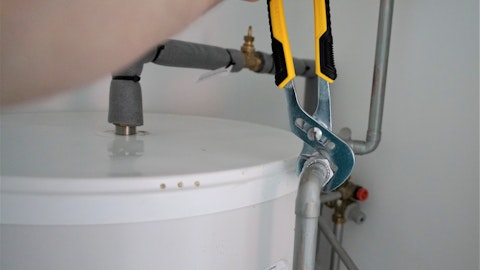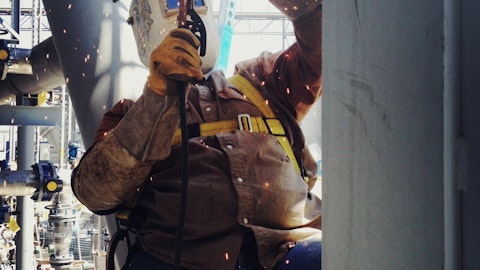Fastenal Company (NASDAQ:FAST) Q3 2023 Earnings Call Transcript October 12, 2023
Fastenal Company beats earnings expectations. Reported EPS is $0.52, expectations were $0.51.
Operator: Hello, and welcome to the Fastenal 2023 Q3 Earnings Results Conference Call and Webcast. [Operator Instructions] A question-and-answer session will follow the formal presentation. [Operator Instructions] As a reminder, this conference is being recorded. It’s now my pleasure to turn the call over to Taylor Ranta of the Fastenal Company. Please go ahead, Taylor.
Taylor Ranta: Welcome to the Fastenal Company 2023 third quarter earnings conference call. This call will be hosted by Dan Florness, our President and Chief Executive Officer; and Holden Lewis, our Chief Financial Officer. The call will last for up to one hour and will start with a general overview of our quarterly results and operations, with the remainder of the time being open for questions and answers. Today’s conference call is a proprietary Fastenal presentation and is being recorded by Fastenal. No recording, reproduction, transmission or distribution of today’s call is permitted without Fastenal’s consent. This call is being audio simulcast on the Internet via the Fastenal Investor Relations homepage, investor.fastenal.com.

Trong Nguyen/Shutterstock.com
A replay of the webcast will be available on the website until December 1, 2023 at midnight Central Time. As a reminder, today’s conference call may include statements regarding the company’s future plans and prospects. These statements are based on our current expectations, and we undertake no duty to update them. It is important to note that the company’s actual results may differ materially from those anticipated. Factors that could cause actual results to differ from anticipated results are contained in the company’s latest earnings release and periodic filings with the Securities and Exchange Commission, and we encourage you to review those factors carefully. I would now like to turn the call over to Mr. Dan Florness.
Dan Florness: Thank you, Taylor. Good morning, everybody, and thank you for joining our third quarter call. I’ll start on the — reference the flip book on Page 3. Conditions remained challenging in the third quarter of ’23, reflected in a daily sales growth rate of 4%. Still, regardless of the year, we celebrate milestones when they occur. I remember just over 10 years ago when we hit $10 billion (ph) in daily sales for the first time, we recognized that on this call, as well as internally to celebrate that milestone. Some years later, we hit $20 million. Here in the month of September, we broke $30 million in sales per day for the first time in our history, and my congratulations to the Fastenal organization for hitting that milestone.
Our sales growth in the quarter translated into EPS growth — EPS of $0.52, 4.1% growth over the same period last year. Our results reflect the unique profile — product profile of our business. Fasteners still constitute about a third of our sales, and within that subcategory, about 63% is in OEM-oriented fastener, and that business can be very cyclical because of the production needs of each of the customers we’re serving. If you look at the rest of the business, it tends to be much more MRO-oriented. Our fastener daily sales, as you’ve seen in our monthly sales release, have decelerated at a faster rate than our non-fastener business as we’ve gone through the calendar year. The third-quarter operating margin hit was 21%, which matched last year despite the one less selling day.
And so, earlier I spoke about the $30 million we do in a day. The quarter had one less day. Many of our — some of our expenses are tethered to the day, most are not. And so, pleased that the team was able to match the operating margin of 21% from last year. But I believe that understates the reality of the performance. If you looked at it on a same-day basis, we believe we would have increased the operating margin, because we’d have had roughly $10 million more, about a third of that $30 million in operating income, because that — a good chunk of that flows through because of the change in the nature of the expense. The Blue Team, if I think about the last several years, we had a unique opportunity to serve the marketplace because of our pristine balance sheet.
When COVID hit the globe back in 2020, we were able to step forward and secure and — and purchase and fund with cash a meaningful increase in inventory, primarily centered on safety supplies, because our customers and society, in general, needed something to get through that period, and we were proud to be part of the solution. We were able to do that because of our balance sheet. As the global economy reemerged from the pandemic, we saw first-hand, and you saw it in daily news clippings, about congestion that was going on in supply chains around the planet. Again, as supply chains became more rocky and you couldn’t rely on how many days it would take to get product, there’s a solution to that. Its stock more product. And we beefed up our balance sheet and our cash flow suffered as a result, but I believe our standing with our customers and in the marketplace never performed better, because the market could rely on the covenant that Fastenal provided to them in being a great supply chain partner.
As we moved deeper into 2022 and now into 2023, we’ve been able to unwind a piece of that. And as a result, our year — on a year-to-date basis, we have converted 121% of our net earnings into operating cash flow. That’s our highest performance in a decade that’s averaged just shy of 100% — about 95%. If I look at it from the standpoint of relative to a year ago, in the quarter, our operating cash grew about 51%. Year-to-date, our operating cash has grown 69%. Again, part of that’s a reflection of the investments we made to serve our marketplace and our ability to unwind that in the current environment and translate that into cash flow for the organization to serve our shareholders and to serve the business as we move into the future. Our Onsite and FMI installed bases and our digital footprint continue to expand.
And earlier this year, we did some restructuring and we announced the elevation of Jeff Watts to Chief Sales Officer in the organization. We did some restructuring of the sales side of our organization, because we wanted to double down on the challenge we’d put in place in front of everybody going back to the 2015 time frame. And that was really stepping into what we saw as an untapped opportunity to grow our business faster, and that was to expand our Onsite presence. It was earlier this year that, for the first time, the number of Onsites in the organization outnumbered the number of branches in the organization, and that delta continues to expand. And we believe that each of our district managers has the potential in their market to land two Onsites per year, and it’s our job and part of the purpose of the restructuring of the sales team was to really just decide, hey, we believe it, but we haven’t done it.
Let’s do this thing. We expanded not too many years ago, we were signing 80 Onsites a year and we laid out the plan to get to 400 a year. We expect, as you see on the next page, we’ll do about 350 this year. But we haven’t hit that number, and we’ve been kind of stuck. Now, COVID threw some challenges our way. It’s never an easy time to move into — move in with somebody when they’re trying to isolate from the rest of the world, and that challenged our ability to grow coming out of COVID. But looking at the opportunity that’s out there, I believe we can do that. We need to turn that belief into a reality. Flipping to Page 4. Speaking of Onsites, we did sign 93 in the quarter. So, our active sites are 1,778, 13.5% greater than they were at the end of third quarter of 2022.
And our daily sales in those Onsites, excluding transferred business when you open an Onsite, is in the low-double digit rates. So, we’re seeing good growth there. We’re just not signing enough. And as I said, we still anticipate signing roughly 350 this year. FMI technology, there we set lofty goals as well. We said, can we do 100 a day? Not 100 a quarter, but 100 a day of our weighted device count. Now, we did 5,969 during the quarter, 95 per day versus 81 a year ago. The team’s performing really well here. We’re not at the 100. The 100 is the goal, and we will push and push and push till we get there. But I’m really proud of what the team is doing, and you see that shine through. When you look at our sales by product line in — in our monthly and quarterly releases, one thing you do see is, our safety business, grew almost 10% in the month of September and a lot of that could be attributed to the success we’re seeing in FMI.
And it’s our anticipation we’ll sign between 23,000 and 25,000 MEUs this year, and that’s a combination of FASTBin and FASTVend. eCommerce, we can — it’s still, in the scheme of things, a relatively small piece of our business. It’s just under 25%, but it’s up from single digits not too many years ago. And it currently grows — it grew about 41% during the quarter. And that’s really a case of the marketplace saying to us, we’d prefer to purchase from you this way, and our team in the field and our team in technology building an ever better mousetrap to serve into that market. As I’ve shared on prior calls, we still have a ways to go on this piece of our business, because a chunk of eCommerce is that unplanned spend, and our goal is to keep making that easier for our team to do in the field.
Finally, if you roll up FMI and eCommerce, we talk about our digital footprint. How much of our revenue is touching some digital aspect of engagement? We were at 57% in the quarter versus 49.5% a year ago. Our challenge to the team is targeting 60% sometime before we exit this year. And our long-term expectation, is still at that 85% we’ve talked about in the past that we believe will be part of our digital footprint as we move into the future. In addition to our earnings release, there’s several 8-Ks that have gone out around the earnings time, and I thought I’d share just some insight on the three. The first one, and I believe it went out yesterday evening after market close, we announced as we do typically on a quarterly basis, a dividend, we bounced to $0.35 dividend, which is consistent with the dividend we paid in each of the first three quarters of the year.
We also announced a few leadership changes. One is, is a press release we put out, one of the individuals that’s been very influential in our ability to beef up our inventory during COVID and wrap it back down and overseeing the distribution and transportation teams as well is Tony Broersma. Tony has been with the organization of roughly 20 years, and he’s demonstrated through a career and we identified that we lay out his career in the press release, the different roles he’s had, but he’s demonstrated excellence. And yesterday, I asked the Board of Directors to elevate him to Executive Vice President over operations. So essentially elevating his role in that his responsibility will be largely unchanged from what we had previously, but it’s recognizing his performance and what we see in the future of Tony within the organization.
Second filing one out. It’s a required filing related to one of our officers who has decided to move on to a new chapter in his career. And it’s Terry Owen, our Chief Operations Officer. I have known Terry for many years. He’s been with the organization. I believe all told, he’s been with the organization about 28 years. The official documents say it’s 24.5 because he was in the earlier years, part of time with the organization, but then came full time and had a break in service there. But Terry has demonstrated a career of exemplary service to the organization. We’ve had some conversations in recent months about some aspirations he had in the — he’s looking at the number of years he has left in his career and what he wants to do as he moves into his next chapter life.
He discovered an opportunity we thought was quite compelling that would serve his desire for the future as well as his family. Terry had relocated to the East Coast of the U.S. several years ago for family reasons. And all I can say that Terry is your good friend. I wish you best of luck in your next endeavor. And thank you for the team that you developed, Tony being one of them, but thank you for the team you developed. The organization has always prided itself on our ability to build leaders and promote from within. And every time we see a person decide to take a new chapter in life, whether that’s after retirement or going into a family business or whatever the case might be. We always see another layer of talent right behind that person ready to step in and discover their future and their opportunity.
With that, I’ll turn it over to Holden.
Holden Lewis: Thank you, Dan. Good morning, everyone. I’m going to start on the slide deck on Slide 5. Total sales in the third quarter of 2023 were up 2.4%, adjusting for the fact that we had one fewer selling day in the quarter, our daily sales were up 4%. Frankly, the dynamics of the quarter varied very little from the second quarter of 2023. Macro data points and feedback from the regional leadership continue to point to sluggish demand and a cautious outlook for spending and production. We are certainly encouraged by the improvement in our September daily sales rate to up 5%. However, it seems to have more to do with easing comparisons in certain parts of our business than a clear signal of firming customer demand or brightening outlooks.
Dynamics around our products, customers and end markets have also trended similarly over the past three months and six months. Manufacturing grew 6.4% despite soft demand, benefiting from further growth in the Onsite installed base and initiatives in national accounts in the field to target key account plan spend, which is disproportionately manufacturing-oriented. Non-manufacturing was down 1.3%, though the rate of decline moderated as we began to hit easier comparisons in non-residential construction, reseller and warehousing customers. From a product standpoint, fasteners are relatively weak at down 2% due to their more cyclical profile and rapid pricing moderation. In contrast, non-fastener products remain healthy, due to further growth in our vending installed base and improved comparisons.
As it relates to pricing, it remains positive but has come back to a range of 0% to 2% that we consider to be typical under normal economic conditions. We did experience very modest deflation within our fastener product line. Now to Slide 6. Operating margin in the third quarter of 2023 was 21%, equaling our margin from the third quarter of 2022. We typically believe that given mid-single digit daily sales growth, we should be able to defend our margin. However, that we were able to do so despite the headwinds related to the one fewer sales day that Dan described in his prepared remarks, points to what we believe was more effective cost management by the Blue Team relative to the second quarter of 2023. Gross margin was 45.9%, flat in the period from the prior year.
Freight remained favorable, reflecting modest leverage of our captive fleet expenses, reduced use of external freight providers, lower fuel and reduced shipping costs. We also benefited from the absence of last year’s $3.4 million glove write-down and slightly positive price-cost. These favorable variables match the margin drag related to product and customer mix. The impact of mix was slightly less negative and the impact of price-cost was slightly more positive than anticipated at the second quarter call. We did not take any incremental pricing actions in the period and the favorable price cost in the current period largely regains the negative price cost we discussed in the third quarter of 2022. We expect price cost to trend neutral in coming quarters.
SG&A was 25% of sales, up from 24.8% of sales, mostly due to the one fewer sales day. We experienced modest payroll leverage with lower incentive pay, reflecting slower growth in the third quarter of 2023 versus the third quarter of 2022. This was more than offset by rising information technology spend, an increase in general insurance costs, increased expenses to maintain our selling related truck fleet and higher bad debt Relative to the second quarter of 2023, the organization tightened its management of discretionary expenses with spending on travel, meals and supplies being down 0.6% year-to-year and continued moderation of growth in our FTE count. Putting everything together, we reported third quarter’s 2023 EPS of $0.52, up 4.1% from $0.50 in the third quarter of 2022.
Turning to Slide 7. We generated $388 million in operating cash in the third quarter of 2023 or 131% of net income in the period. Cash generation is traditionally strong in third quarter, though conversion in the current quarter was stronger than its historically typical. This reflects reduced need for working capital as demand slows down and improvements in inventory. The resulting strong cash flow means our balance sheet remains conservatively capitalized at the end of the third quarter of 2023 with debt ending at 7% of total capital versus 9.4% in the second quarter of 2023 and 14.9% in the third quarter of 2022. Year-over-year, accounts receivable were up 5.4%, which is a combination of sales growth and the impact of mix due to faster growth of larger customers, which tend to have longer terms.
Inventories fell 9.8%, slower customer demand reduced working capital needs. We are unwinding inventory layers built in late 2021 and early 2022 to manage supply chain constraints. And our field and hub operations have sustainably streamlined inventory processes. Our days on hand fell again to 134.6 days, the lowest since 2002, which reflects improved velocity of inventories through our internal network, a reduction of retail stock in branches and improvements in stocking processes. We reduced our net capital spending range to $180 million to $190 million, down from $210 million to $230 million. This largely reflects timing and deferrals related to hub automation and expansion projects that we do expect to be included in next year’s capital spending plans.
The third quarter of 2023 profiled very similarly to the second quarter of 2023. We continue to experience stagnant demand, a cyclical shift favoring non-fasteners and a secular shift favoring larger manufacturing-oriented customers. Growth driver performance is not quite where we would like it to be, but it’s at levels that continue to support good growth in our installed base, success in providing differentiated value to our customers and further cost and asset efficiency. Operating margin performance remained stable despite the slow growth and our capacity to generate cash to reinvest in the business remains strong. We did begin to experience easier comparisons in certain markets, and our management of discretionary expenses improved over the preceding quarter.
We continue to believe we are positioned to meaningfully accelerate sales growth when underlying demand improves while sustaining strong profitability and returns. With that, operator, we’ll turn it over to begin the Q&A.
See also 20 Best E-Commerce Platforms for Small Businesses in 2023 and 15 Most Common Reasons You’re Likely to Get Fired.
Q&A Session
Follow Fastenal Co (NASDAQ:FAST)
Follow Fastenal Co (NASDAQ:FAST)
Operator: [Operator Instructions] Our first question is coming from Nigel Coe from Wolfe Research.
Nigel Coe: Thanks. Good morning, everyone.
Dan Florness: Good morning.
Nigel Coe: So the price cost definitely coming a bit better than what we expected. Is this as simple as thinking about the ocean freight rate normalization and we’re starting to see that now coming through from inventory. So I’m just wondering if when we obviously talk about the freight benefits, just wondering if that’s more ocean bound freight as opposed to domestic.
Holden Lewis: I think, Nigel, there’s a little bit of that, that’s flowing through, but we’ve definitely seen lower costs related specifically to our fastener line. And I think that’s largely what you’re seeing. So yeah, when we think about what caused a lot of the inflation in our business, there was an element of it that was raw material, but there was a fairly significant element that was related to transportation. And so yeah, I think you’re just seeing some of that gradual impact play through. But I want to also give a lot of credit to the organization, particularly sort of the field and the national accounts teams and the folks that manage pricing. I mean, I believe five years ago that we wouldn’t as effectively have been able to align our pricing and cost in the way we have.
The variance that we’ve had against what’s going on in the market has been fairly tame. If you remember, this quarter last year, we were talking about 20 basis point deficit and we felt that, that was going to — we felt at the time that we hadn’t quite caught up with where costing went with fasteners. I think our guidance at the time was we kind of expect that costing to catch up. It has caught up and probably came in a little bit. But I think over coming quarters, you’re going to see the benefit that we saw this quarter, which largely recaptures the deficit we saw a year ago. I think you’re going to see that begin to moderate. So it wasn’t what we expected either. As you know, we target neutral, we continue to target neutral. But I don’t think that it’s a — I don’t think it’s a sustained trend either.
I think as we go through the next couple of quarters, it’s going to trend back to neutral.
Nigel Coe: Okay. Thanks, Holden. And then on the CapEx pushouts of the projects, was that an elected push out? Just want to see if that was maybe just, I don’t know, supply chain challenges or delays from a supply side or was that elective.
Holden Lewis: The majority of it was not elective. We had a — there’s a piece of property in there. The signing of which just got pushed out from fourth quarter to first quarter, that’s just a calendar timing issue. We did have some automation projects where it’s just a matter of when the product is going to come in. We always do it would be later in the year and it’s just going to sort of cross the calendar line. So the majority of it relates to projects that we remain committed and excited about and will fall into the 2024 and it was more a function of timing. Now I will say that earlier in the year, we did say, look, take a look at your budgets, it’s not a great year in terms of demand and tighten some stuff up. So I think there’s some elements in there of what you’re talking about, and that’s just about enforcing discipline across the organization. But I think the larger portion of it relates to projects that will be coming back into the business in 2024.
Nigel Coe: Got it. Okay. Thanks a lot.
Holden Lewis: Thank you.
Operator: Thank you. Next question is coming from Chris Snyder from UBS. Your line is now live.
Christopher Snyder: Thank you. I wanted to follow up on some of the price cost commentary. I understand that price cost was positive from a year-on-year perspective. But I think you said the deficit was largely caught up, from which would kind of maybe imply that you’re still a bit price cost negative at the moment. So when we think about that trajectory back to neutral, is that like incremental price cost positive to get there or is that incremental price cost give back to get there? Thank you.
Holden Lewis: I mean I guess I’m viewing the next couple of quarters as being the inverse of the last few. Again, if you remember, in Q3, we talked about fasteners, we had a little bit of a deficit in price-cost. And the guidance at the time was that over the next few quarters, you would see that deficit begin to decline. Was there a fastener deficit in Q4? Yes, there was. Is it possible that we get that fastener deficit from Q4 back in Q4 of this upcoming quarter? Yeah, I think that that’s possible. But the deficit Q4 last year was not as wide as the deficit in Q3, and I’m not expecting the benefit in Q4 this year to be at the same level as the benefit we saw in Q3. Really, again, this feels very much like the inverse of what occurred last year. And at the end of the day, yeah, we’ll probably wind up over the course of multi-years kind of being neutral from a price cost standpoint. But within that overall trend, there’s been a little bit of swinginess.
Christopher Snyder: Thank you. I appreciate that. And then maybe could you just talk a little bit about pricing on the non-fastener side? I think I understand that the fastener is seeing some price pressure, whether it’s the metal or the freight. But can you talk about the non-fastener side of the business? Thank you.
Holden Lewis: Yeah. We don’t talk about [indiscernible] behaving largely like we would expect it to. Pricing in the non-fastener areas has moderated just like our overall pricing has, but much like our overall pricing levels at this point, it’s kind of back in the range that we would normally expect it to be in. It’s still positive. It’s lower than it was a year ago. But frankly, that area is performing largely as we expected. Historically, we have not traditionally seen negative pricing in non-fastener products. And I don’t expect that, that’s going to happen in this cycle either. So we view that the conditions for pricing in those products to be pretty stable here.
Christopher Snyder: Thank you.
Operator: Thank you. Next question is coming from David Manthey from Baird. Your line is now live.
David Manthey: Dan, Holden, good morning.
Holden Lewis: Hi, Dave. Good morning.
David Manthey: First question, could you talk about the feedback and early returns after you reopened the front doors of your stores last month?
Dan Florness: I don’t — there hasn’t been a lot of feedback. One thing I do every day, and I’ve done this, quite frankly, have done this for the last eight years is I — and each day in every web feedback that comes in from customers, I try to read. I’m not going to say I read 100%, but I tried to. And that tells you it’s a small enough number that I’m able to even try to, when you consider the hundreds of thousands of customers we have. And over time, you pick up different themes. And obviously, you could — if I go back to the COVID era, boy, were there themes jumping out. The themes were a society really frustrated, not with us, just with some — just frustrated. Scared about what’s going on. Most of our business is in the U.S. and so scared about what was going on and things that were going on and chaos around them.




